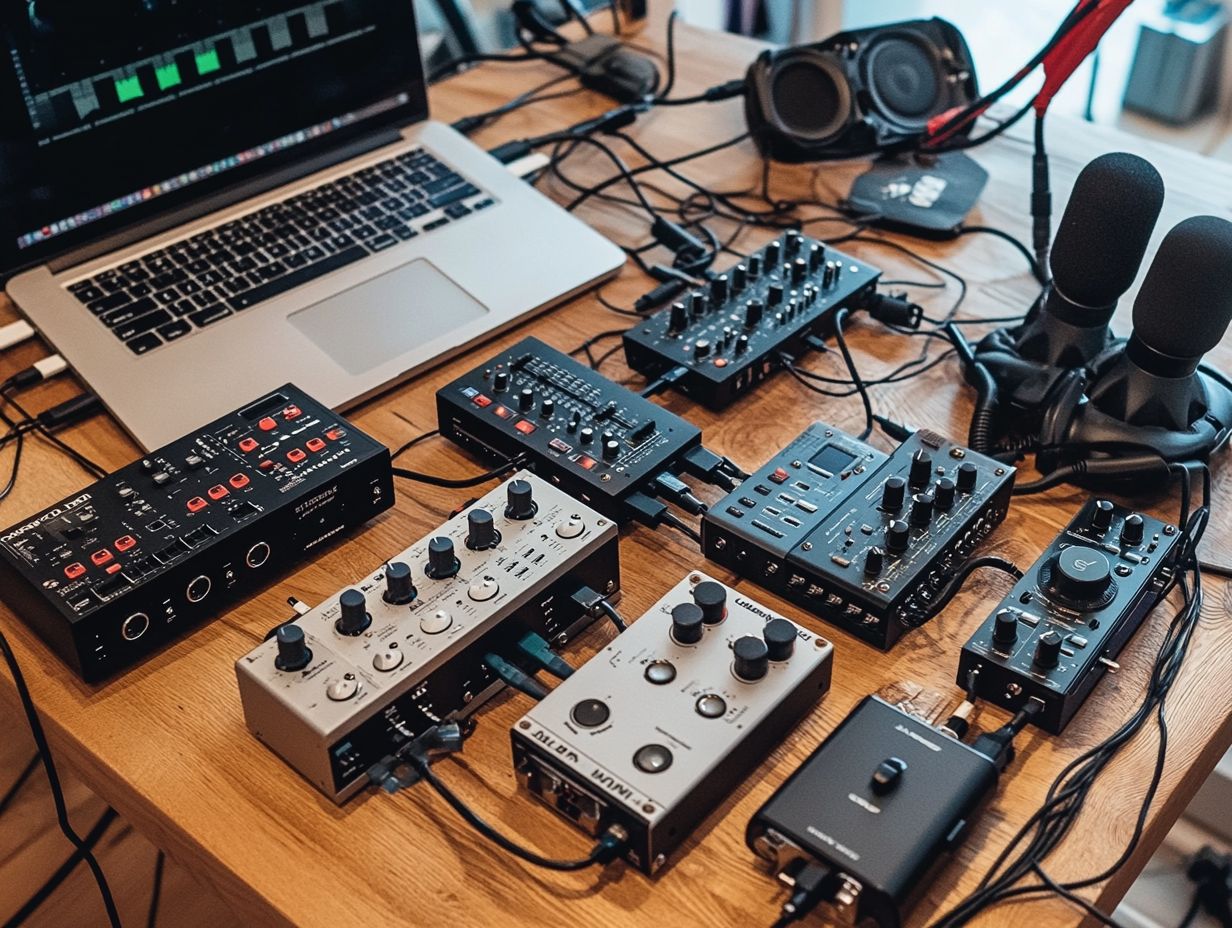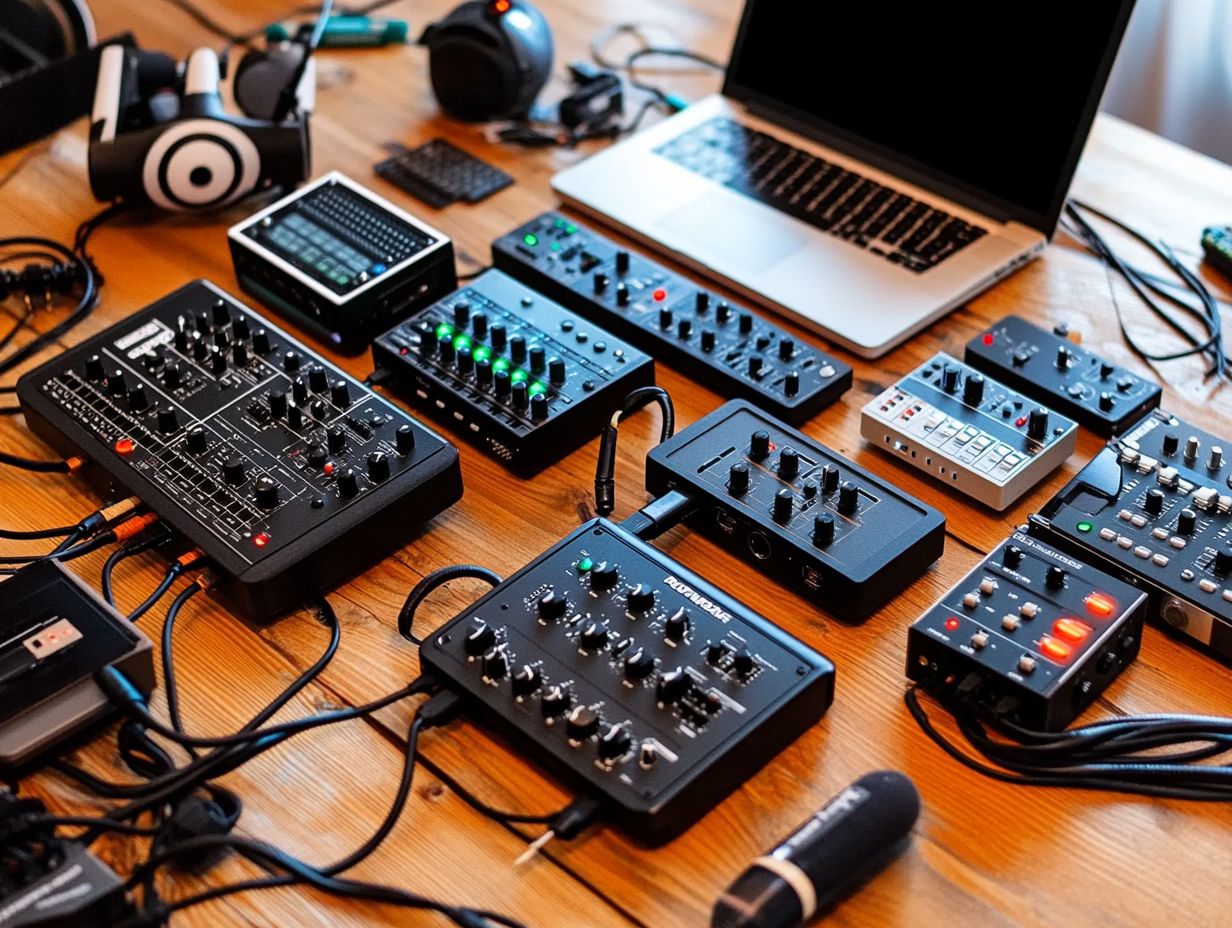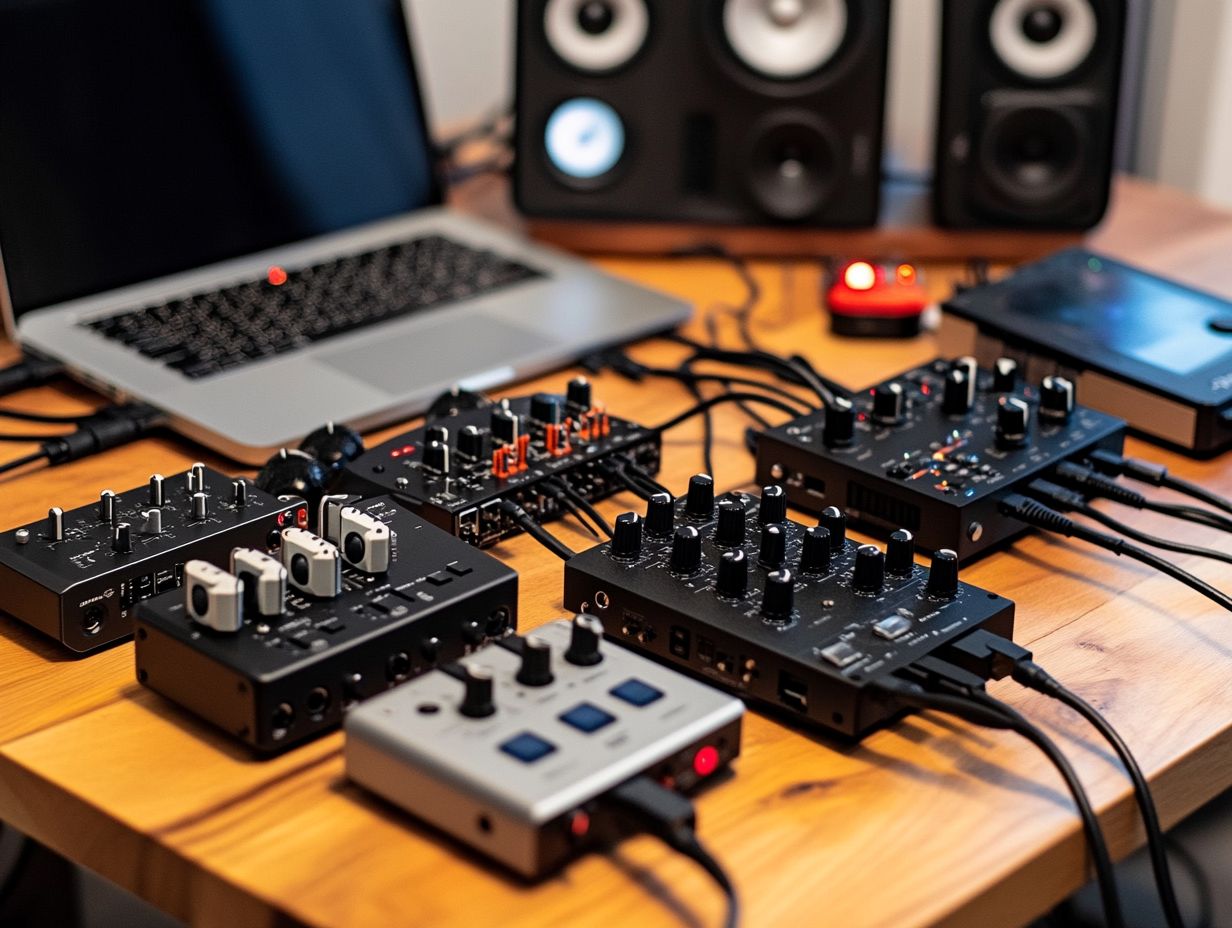In the realm of music production, the selection of appropriate tools is critical, and audio interfaces are no exception. These essential devices serve as a conduit between your computer and your instruments, significantly enhancing sound quality and overall performance.
For those operating within a budget, the question often arises as to whether it is possible to achieve professional results without incurring excessive expenses. This article will examine the advantages of budget audio interfaces, outline key factors to consider when selecting one, and provide reviews of leading models.
Additionally, we will offer strategies to help you optimize performance and maximize the value of your investment. Explore the insights presented here to discover how you can enhance your audio production capabilities affordably.
Understanding Audio Interfaces

A comprehensive understanding of audio interfaces is crucial for musicians, producers, and sound engineers, as these devices function as the intermediary between analog audio sources and digital audio workstations (DAWs).
Audio interfaces convert sound signals into digital audio, enabling processing, recording, and editing on a computer while ensuring high-quality audio fidelity and performance during studio, home, or mobile recording sessions.
Whether one is in search of an economical audio interface or the optimal budget-friendly option, selecting the appropriate device can have a substantial impact on audio production and creative endeavors.
What are Audio Interfaces?
Audio interfaces are essential devices that establish a connection between audio sources, such as microphones and musical instruments, and computers. They perform the crucial function of converting analog signals into digital data, which can then be processed by a digital audio workstation (DAW).
These components significantly enhance recording quality by providing high-resolution audio conversion and offering various input and output options tailored to different recording setups.
Among the wide range of audio interfaces available, USB interfaces are particularly favored due to their ease of use and compatibility with most computers, making them well-suited for home studio environments.
In contrast, portable audio interfaces address the needs of mobile recording, enabling musicians and sound engineers to create high-fidelity recordings while on the move. The importance of these devices lies in their capacity to improve overall sound quality and streamline the recording process, thereby making professional-grade audio accessible to creators at all levels.
Benefits of Using Budget Audio Interfaces
Budget audio interfaces present an excellent opportunity for musicians and audio enthusiasts to attain high-quality audio performance without incurring significant expenses.
They enable entry-level users to pursue their interests in music production or sound design without a considerable financial commitment.
These cost-effective audio interfaces are engineered to provide consistent and reliable performance at lower price points, making them an appealing choice for individuals establishing a home studio or participating in mobile recording endeavors.
Cost Savings and Quality Performance
One of the most compelling reasons to select budget audio interfaces lies in their ability to offer a balance between cost efficiency and quality performance, enabling users to experience high-quality audio without incurring substantial expenses.
These interfaces frequently utilize advanced technology to ensure clarity and fidelity in audio reproduction, making them suitable for both emerging musicians and established professionals.
For instance, reputable brands such as Focusrite and PreSonus offer models like the Scarlett 2i2 and the AudioBox USB, which exemplify this equilibrium by providing excellent sound quality and versatile features at a significantly lower price point compared to high-end alternatives.
Users can anticipate reliable performance whether in recording studios or home setups, facilitating a seamless transition from creation to production. Ultimately, these budget-friendly options give the power to creators to uphold professional standards without substantial financial investment.
Factors to Consider When Choosing a Budget Audio Interface

When selecting the most suitable budget audio interface, it is essential to consider several factors that directly impact audio production quality and user experience.
Key considerations include compatibility with your Digital Audio Workstation (DAW), necessary features, and the price point. A thorough understanding of these elements will enable you to make an informed decision that aligns with your recording requirements while ensuring sound clarity and efficient performance in your home studio or mobile recording environment.
Compatibility, Features, and Price
Compatibility with various operating systems and digital audio workstations (DAWs) is a critical consideration when evaluating budget audio interfaces, as it facilitates seamless integration within existing setups. This aspect significantly impacts both the ease of use and the overall effectiveness of music production endeavors.
When assessing a budget audio interface, it is essential to pay close attention to key features such as latency, which can greatly influence recording and monitoring experiences. High-quality microphone preamps are crucial for capturing clear audio signals, while multiple connectivity options enhance versatility by accommodating various input types.
Additionally, it is prudent to consider the price, ensuring that the selected equipment strikes an appropriate balance between functionality and cost-effectiveness, thereby aligning with both creative requirements and budget constraints.
Top Budget Audio Interfaces
Identifying the leading budget audio interfaces necessitates a thorough evaluation of product reviews and comparisons, alongside an assessment of brand reputation and customer satisfaction.
This approach ensures the selection of a device that effectively fulfills audio production requirements while maintaining high performance standards.
Product Reviews and Comparisons
Product reviews and comparisons are essential tools for consumers seeking to identify the best budget audio interfaces available in the market, as they elucidate key features, sound quality, and user experiences.
Among the myriad of options, certain models, such as the Focusrite Scarlett 2i2 and the Behringer UMC22, frequently emerge in discussions. The Scarlett 2i2 is highly regarded for its exceptional preamps and low latency, rendering it an excellent choice for musicians and podcasters.
In contrast, the UMC22, while more economically priced, provides commendable performance, albeit with fewer high-end features.
User feedback consistently highlights the significance of reliable connectivity and ease of use in these devices, alongside factors such as durability and brand reputation. These considerations play a crucial role in guiding potential buyers during their selection process.
Tips for Getting the Most Out of Your Budget Audio Interface

To maximize the potential of a budget audio interface, it is essential to implement strategies that optimize performance and ensure the highest audio quality for recordings, regardless of whether one is producing music, podcasting, or engaging in sound design.
Optimizing Performance and Quality
Optimizing performance and audio quality is essential when utilizing a budget audio interface, as it can significantly influence the recording and mixing experience, resulting in clearer sound and improved overall outcomes.
Employing various techniques can lead to noteworthy enhancements in this regard. For example, adjusting latency settings can facilitate smoother playback and recording, thereby preventing frustrating delays that may disrupt the creative process.
Utilizing appropriate monitoring tools enables better oversight of sound levels and clarity, ensuring that every nuance is captured with precision. Additionally, implementing noise reduction strategies, such as employing high-quality cables and soundproofing the recording environment, minimizes unwanted interference, further refining the quality of the audio signal.
By concentrating on these critical elements, users can fully realize the potential of their budget audio interfaces.
Frequently Asked Questions
What are the top budget audio interfaces available in the market?
Some of the top budget audio interfaces include Focusrite Scarlett Solo, PreSonus AudioBox USB 96, Behringer U-Phoria UM2, M-Audio AIR 192|4, Native Instruments Komplete Audio 1, and Tascam US-1×2.
What features should I look for when choosing a budget audio interface?

When choosing a budget audio interface, look for features such as the number of channels, connectivity options, sample rate and bit depth, compatibility with your computer and software, and any additional features such as built-in effects or MIDI connectivity.
Do I need a high-end audio interface for home recording?
No, a high-end audio interface is not necessary for home recording. Budget audio interfaces offer good quality sound and enough features for basic home recording needs. However, if you are a professional musician or producer, investing in a higher-end audio interface may be beneficial for the added features and higher quality sound.
Can I use a budget audio interface for live performances?
Yes, budget audio interfaces can be used for live performances. However, it is important to check the stability and latency of the interface to ensure a smooth and reliable performance.
Are there any budget audio interfaces that are compatible with both Mac and PC?
Yes, there are many budget audio interfaces that are compatible with both Mac and PC. Some examples include Focusrite Scarlett Solo, PreSonus AudioBox USB 96, and Behringer U-Phoria UM2.
Is it necessary to have a budget audio interface for recording vocals and instruments?
While it is not necessary to have a budget audio interface for recording vocals and instruments, it can significantly improve the sound quality and provide more control over the recording process. It also allows for better connectivity and integration with other recording equipment.


 Discover the Top Headphones for Music Production: A Comprehensive Guide
Discover the Top Headphones for Music Production: A Comprehensive Guide